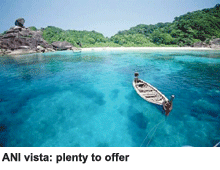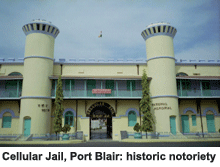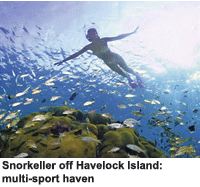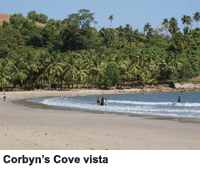For adventure seekers as well as lovers of history, this archipelago of 572 emerald islands, islets and rocks — an indigeneous mirror image of the Maldives — has plenty to offer
 For 21st century India’s multiplying tribe of water sports, snorkelling and scuba diving enthusiasts, the Republic of the Maldives with its 1,200 tiny coral islands set in the azure Indian ocean — and only a 30 minute airplane ride from Thiruva-nanthapuram (Kerala) — is the most preferred rest and recreation destination. In 2008, an estimated 50,000 Indian citizens visited the Maldives. However all said and done, the neighbouring island republic is a foreign country where only hard currency is accepted by way of payment, and affluent occidental and Far East visitors tend to get preferential treatment.
For 21st century India’s multiplying tribe of water sports, snorkelling and scuba diving enthusiasts, the Republic of the Maldives with its 1,200 tiny coral islands set in the azure Indian ocean — and only a 30 minute airplane ride from Thiruva-nanthapuram (Kerala) — is the most preferred rest and recreation destination. In 2008, an estimated 50,000 Indian citizens visited the Maldives. However all said and done, the neighbouring island republic is a foreign country where only hard currency is accepted by way of payment, and affluent occidental and Far East visitors tend to get preferential treatment.
This reality perhaps explains the rising popularity of India’s very own Andaman and Nicobar Islands (ANI) over whose 536 uninhabited and 36 inhabited islands spread over an area of 700 km in the Bay of Bengal — an indigenous mirror image of the Maldives — the tricolour flies with considerable aplomb. Over the past quinquennium the number of tourist footfalls — mainly from the mainland — has risen from 650,000 in 2005 to 750,000 last year (2009).
For adventure seekers as well as lovers of history, this beguiling archipelago of 572 emerald islands, islets and rocks, has plenty to offer. Once a hill range extending from Burma (Myanmar) to Indonesia, these undulating islands are blanketed with dense forest, rich and lush in exotic species of flowers, birds and rare hunter tribes. Mythologicaly, the name Andaman was presumed to be derived from Hanuman, known to the Malays as Handuman, and for a long time, the dense flora and isolation from the mainland cut off the Andaman and Nicobar Islands from civilisation, until they were discovered by the British in the late 18th century. After sporadic initial attempts to ‘settle’ the islands which were abandoned in 1796, following the Indian Mutiny, aka the First War of Independence (1857), their isolation proved useful to the Imperial government as a penal settlement. Convicts and criminals were shipped across the kala pani to be lodged in the islands’ infamous Cellular Jail in Port Blair (pop. 100,186), which has since been converted into a national memorial.
Flora and fauna. Although the history of ANI varies from hosting criminals to retired service personnel and the native tribal population, the topography of the region is mountainous and abounds in evergreen forests. Forests of the islands are a treasured resource for the natives, since they host around 150 plant and animal species and 271 varieties of bird life. To conserve these valuable living resources, 86 percent of the territory is reserved and protected and about 50 percent of forest land has been set aside as tribal reserves, national parks and wildlife sanctuaries. Luxuriant man-groves, perhaps the richest in the world, occupy nearly 5 percent of the islands’ territory.
Marine attraction. Cool and immense blue waters trimmed with milky beaches are the magnet of these scattered islands. Water sports and leisure lovers are increasingly descending on ANI for snorkelling, scuba diving, deep sea fishing, as well as for observing its filigreed colonies of coral and marine life. Sports and recreation activities are priced affordably for Indian tourists. In the Andaman Water Sports Complex, Corbyn’s Cove Tourism Complex, Mahatma Gandhi Marine National Park, Havelock and other islands, instructors school visitors virtually from dawn to dusk, depending on weather conditions.
But unfortunately, over the years mass tourism has placed undue pressure on the precious coral reefs and marine life, endangered by eco-ignorant tourists and souvenir collectors. This has necessitated the rigorous appli-cation of the Wildlife Protection Act of 1972 in the islands, and establishment of the Mahatma Gandhi Marine National Park in Wandoor, 29 km from Port Blair. Sprawled over 15 islands aggregating 281 sq km, the park plies glass-bottom boats, and offers other eco-friendly options to experience the ANI’s unique labyrinths of marine and submarine treasures.
Tribes of Andaman and Nicobar islands. Modern city dwellers are fascinated by ANI’s indigenous population, with some tribes still to be identified and classified. Fiercely proud and independent, the aborigines are bound to the land and their culture, customs and knowledge. The influx of tourists has not, so far, upset the balance between them and their natural environment, and they have steadfastly resisted modernisation. Significant among the major identified tribes are the Great Andamanese, Jarawas, Sentin-elese, Onges, Nicobarese and Shompens. Following massive and continuous migration from the mainland, some of these faraway tribes are sadly on the verge of extinction, because of strange afflictions and diseases imported into the islands by immigrants. One of the most prominent and friendly tribals of ANI are the Jawaras. Concentrated in the north-western coast of the South Andaman and the south-western Middle Andamans, they number a mere 200, but have begun to accept modern schooling and healthcare.
Port Blair. This administrative capital was named after Lt. Reginald Blair who conducted a survey of the area in 1789. It is the only town of any size on the islands with a market — Aberdeen Bazar — which has the cheerful air of any ragingly colourful Indian market. Precariously situated on the main harbour, its hilly topography offers breathtaking views of the Indian mainland from several vantage points. The government of India tourist office is ludicrously located, at least a 20 minute walk from any recognisable place, but it is the venue for information about boats to other islands, sightseeing tours, and several permits which are mandatory.
 Cellular Jail. Although it has latterly transformed into a much-favoured tourist destination rivalling the Maldives if not quite Phuket (Thailand) or Bali (Indonesia), ANI attained historic notoriety as a penal settlement. Following the Indian Mutiny of 1857 in north India, scores of rebel leaders not directly involved in murder and mayhem (who were executed) were transported across the 1,000 km divide of kala pani (black waters) to Andaman and Nicobar. Initially they were locked up in barracks in Port Blair, Ross Island and in concrete structures on Viper Island. The prisons housed many notable Indian freedom fighters including Veer Savarkar, who were cruelly tortured in these jails. Work on the Cellular Jail sited on the outskirts of Port Blair began in 1890 and the gigantic brick and concrete structure, symbolising the might and power of imperial rule, was completed in 1906.
Cellular Jail. Although it has latterly transformed into a much-favoured tourist destination rivalling the Maldives if not quite Phuket (Thailand) or Bali (Indonesia), ANI attained historic notoriety as a penal settlement. Following the Indian Mutiny of 1857 in north India, scores of rebel leaders not directly involved in murder and mayhem (who were executed) were transported across the 1,000 km divide of kala pani (black waters) to Andaman and Nicobar. Initially they were locked up in barracks in Port Blair, Ross Island and in concrete structures on Viper Island. The prisons housed many notable Indian freedom fighters including Veer Savarkar, who were cruelly tortured in these jails. Work on the Cellular Jail sited on the outskirts of Port Blair began in 1890 and the gigantic brick and concrete structure, symbolising the might and power of imperial rule, was completed in 1906.
The jail owes its nomenclature to its architecture — it is wholly made up of individual cells for solitary confinement. The agony of incarcerated prisoners and freedom fighters, who landed here by circumstance of history, is brought alive when visiting the various areas within the premises, as also by a moving son et lumiere (sound and light) show (Rs.20) staged every evening in the jail premises. The show provides a brief glimpse of one of the darkest chapters of British rule and is a must-see for visitors to ANI.
Island cruises. As most of the islands are reserves where tribes are protected from human intervention, only a limited few are open to visitors. Hotels and tour operators in Port Blair organise day picnics, scuba diving and snorkelling trips to Bird, Grub Jolly Boy, Red Skin, Ross and Snob islands, and overnight excursions to Cinque Island which includes a small trek through the forest, offering much scope for languorous bird watching. From Port Blair’s Marine Jetty, daily ferries ply across the harbour to Aberdeen Market and Vyper Island, where the remains of the gallows tower built by the British are still visible. The ferry rumbles past the Chattam Saw Mill, situated on an island off Haddo, and the huge, floating dry dock facility. Cruises are organised by the department of information, publicity and tourism, as well as hotels.
Baratang Island. Covering an approximate area of 238 sq km, Baratang is remote and isolated, which makes it a less frequented spot. The four hour ride from Port Blair (100 km) possibly dampens the thrill, but if you remain resilient and make it all the way, this never-never island is definitely worth the time. It is the habitat of one of the rarest and most primitive tribes — the Jarawas — and one can occasionally catch a glimpse of them on the street looking for paan. The mud volcanoes, Parrot island, limestone caves, mangrove creeks and delectable fish curry define Baratang. It can be reached via a local bus or a private vehicle.
 Havelock Island. Situated 38 km from the main town of Port Blair, Havelock Island is a spectacular destination. Spanning an area of 100 sq km, only a third of the northern island is populated. It’s a natural paradise, a fascinating realm of powder beaches, glittering water, coral reefs and many-splendoured marine life. A multi-sport haven, the island is a great base for hiking, fishing, kayaking, snorkelling, and sailing to other islands. The beaches are awesome. Radhanagar beach aka Beach No.7 and Vijaynagar beach aka Beach No.5 are a visitor’s delight. The island is accessible only through water with an option of choosing an AC boat which takes about an hour and a half or the government ferry which takes about two and a half hours to reach Havelock. The service is available everyday in the morning and evening.
Havelock Island. Situated 38 km from the main town of Port Blair, Havelock Island is a spectacular destination. Spanning an area of 100 sq km, only a third of the northern island is populated. It’s a natural paradise, a fascinating realm of powder beaches, glittering water, coral reefs and many-splendoured marine life. A multi-sport haven, the island is a great base for hiking, fishing, kayaking, snorkelling, and sailing to other islands. The beaches are awesome. Radhanagar beach aka Beach No.7 and Vijaynagar beach aka Beach No.5 are a visitor’s delight. The island is accessible only through water with an option of choosing an AC boat which takes about an hour and a half or the government ferry which takes about two and a half hours to reach Havelock. The service is available everyday in the morning and evening.
 Beaches. The closest beach is Corbyn’s Cove, 10 km from Port Blair. The easiest way to get there is to hire a bicycle from Aberdeen Bazaar and cycle out for the day. There are facilities to windsurf and enjoy other water sports, and after a long, sunny day you could step into the Andaman Beach Resort for a beer. There are other inviting beaches at Wandoor (25 km) and Chirya Tapu at the southern tip of the islands. The neighbouring Snake Island is a web of coral reefs. You can sometimes catch a ride to the island in a fishing boat. If you do visit, watch out for snakes.
Beaches. The closest beach is Corbyn’s Cove, 10 km from Port Blair. The easiest way to get there is to hire a bicycle from Aberdeen Bazaar and cycle out for the day. There are facilities to windsurf and enjoy other water sports, and after a long, sunny day you could step into the Andaman Beach Resort for a beer. There are other inviting beaches at Wandoor (25 km) and Chirya Tapu at the southern tip of the islands. The neighbouring Snake Island is a web of coral reefs. You can sometimes catch a ride to the island in a fishing boat. If you do visit, watch out for snakes.
Mini zoo and forest museum. The Andaman and Nicobar Islands are home to over 200 indigenous animal species found nowhere else on the planet, some of which can be viewed in the mini zoo on Haddo road. It houses the imperial green pigeon and the Andaman pig, the staple diet of some tribal groups. The zoo’s saltwater crocodile breeding programme has done remarkably since its inception, with many reptiles having been successfully released into the wild.
Anthropological museum. The museum exhibits a mini-reproduction of the settlements of local tribes, and is a valuable source of information about their lifestyles and culture. Although small, it has a well-stocked library of ethnographic and anthropological books and journals.
Other places of interest. Check out the Burmese temple in Phoenix Bay, and Ghol Ghar spice stores as well as the local Cottage Industries Emporium. Excursions can be arranged from Port Blair to the Botanical Gardens (14 km), Burmah Nullah and the Wimberygunj Lumber Centre, in the jungle. The aquarium and the Samudrika Marine Museum display some of the 350 species of fish found in the Andaman Sea.
Getting to ANI. Port Blair cannot be accessed by road or rail. Direct flights are available only from Chennai and Kolkata and it takes about two hours to reach Port Blair. If flying from anywhere else, you need to hop planes from the above cities. You can also reach Port Blair by ship from Chennai and Kolkata. The voyage takes about three days each way and can be tiring.
Accommodation. Top-end: Fortune Resort — Bay Island (Rs.2,749-3,960 per night); Peerless Resort (Rs.2,250-3,650). Mid-range: Andaman Teal House (Rs.400-800), Hotel Aparupa (Rs.750-1200); Sun Sea Resort (Rs.900-1250). Budget: Youth Hostel (Rs.50-100), Central Lodge (Rs.70-150), Jagannath Guest House (Rs.60-300).
The prime time to visit the Andaman and Nicobar Islands is between December to April.
Neha Ghosh